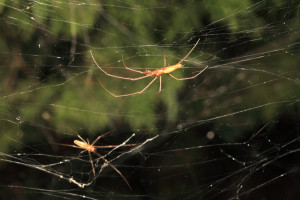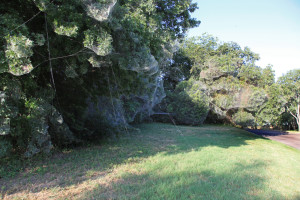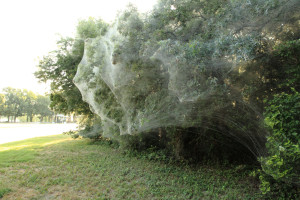Rowlett, Texas is a relatively quiet suburb of big neighbor, Dallas. Driving along the city’s CA Roan Drive, a quiet stretch of road running through Lakeside Park South, you can feel a long way from the big city. But cyclists and drivers along that route this week may have noticed the trees looking a little shiny, and maybe just a little creepy.
Along a football field length stretch of the drive, the spiders are taking over. Glistening webs are draping the trees like shrouds at Lakeside Park, a stone’s throw away from the shores of Lake Ray Hubbard. Someone stepping off the road for a closer look will see thousands of lanky spiders darting among the webs that extend up to 40 feet into the trees.
It turns out that while rare, large webs like this do occur from time to time. In 2007 local news stations reported a similar giant spider web at Lake Tawakoni State Park, about 35 miles east of Rowlett. At the time the web was more than creepy–it was a revelation to many arachnologists (spider experts).
If you’ve ever watched them you may have noticed that, like their comic book friend Spiderman, spiders tend to work alone. So it was surprising, even to many arachnologists, to find spiders in a communal setting, apparently building a nest together. The spiders turned out to be Tetragnathus guatamalensis, a spider previously reported to build communal nests when conditions are right.

While the exact species has not been confirmed, the communal spiders are some kind of long-jawed spider. These spiders are unusual in that they are not aggressive to other spiders of the same species. They also are not known to bite or be harmful to humans.
The right conditions appear to include a glut of small insects like midges that emerge at night from lakes. Without lots of food, these communal webs just don’t seem to form. Dr. Roy Vogtsberger, of Midwestern State Univerisity in Wichita Falls, TX, has been studying the Tawakoni site since it stirred up worldwide interest in 2007. He reports that the communal web has never returned. It appears that these spider “art exhibits” are relatively rare.
“What is really interesting about these spider aggregations is the lack of aggression among spiders of the same species on the same web. They can be extremely close proximity [and still tolerate each other],” said Vogtsberger.
If you get the chance to take a drive along CA Roan Drive in Rowlett, take a few moments to admire the spider handiwork. But please don’t touch the art.

